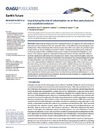Identificador persistente para citar o vincular este elemento:
https://accedacris.ulpgc.es/jspui/handle/10553/45672
| Campo DC | Valor | idioma |
|---|---|---|
| dc.contributor.author | Smith, Alexander B. | en_US |
| dc.contributor.author | Jackson, Derek W.T. | en_US |
| dc.contributor.author | Cooper, J. Andrew G. | en_US |
| dc.contributor.author | Hernández Calvento, Luis Francisco | en_US |
| dc.contributor.other | Hernandez Calvento, Luis | - |
| dc.contributor.other | Jackson, Derek | - |
| dc.contributor.other | Cooper, Andrew | - |
| dc.contributor.other | Smith, Alexander | - |
| dc.date.accessioned | 2018-11-22T11:40:29Z | - |
| dc.date.available | 2018-11-22T11:40:29Z | - |
| dc.date.issued | 2017 | en_US |
| dc.identifier.issn | 2328-4277 | en_US |
| dc.identifier.uri | https://accedacris.ulpgc.es/handle/10553/45672 | - |
| dc.description.abstract | Rapid urban development has been widespread in many arid regions of the world during the Anthropocene. Such development has the potential to affect, and be affected by, local and regional dunefield dynamics. While urban design often includes consideration of the wind regime, the potential impact of construction on the surrounding environment is seldom considered and remains poorly understood. In this study, regional airflow modeling during successive stages of urbanization at Maspalomas, Gran Canaria, Spain, indicates significant and progressive flow perturbations that have altered the adjacent dunefield. Significant modifications to the boundary layer velocity, mean wind directionality, turbulence intensity, and sediment flux potential are attributed to the extension of the evolving urban geometry into the internal boundary layer. Two distinct process/response zones were identified: (1) the urban shadow zone where widespread dune stabilization is attributed to the sheltering effect of the urban area on surface wind velocity; and (2) the acceleration zone where airflow is deflected away from the urbanized area, causing an increase in sediment transport potential and surface erosion. Consistent coherent turbulent structures were identified at landform and dunefield scales: counter-rotating vortices develop in the lee-side flow of dune crests and shedding off the buildings on the downwind edge of the urban area. This study illustrates the direct geomorphic impact of urbanization on aeolian dunefield dynamics, a relationship that has received little previous attention. The study provides a template for investigations of the potential impact of urbanization in arid zones. | en_US |
| dc.format | application/pdf | - |
| dc.language | eng | en_US |
| dc.relation.ispartof | Earths Future | en_US |
| dc.rights | by-nc-nd | - |
| dc.source | Earths Future [ISSN 2328-4277], v. 5 (5), p. 520-539 | en_US |
| dc.subject | 54 Geografía | en_US |
| dc.subject | 5404 Geografía regional | en_US |
| dc.subject.other | Aeolian dynamics | en_US |
| dc.subject.other | Anthropogenic impact | en_US |
| dc.subject.other | Turbulence | en_US |
| dc.subject.other | Coherent flow structures | en_US |
| dc.subject.other | 32 CFD modelling | en_US |
| dc.title | Quantifying the role of urbanization on airflow perturbations and dunefield evolution | en_US |
| dc.type | info:eu-repo/semantics/article | en_US |
| dc.type | Article | es |
| dc.identifier.doi | 10.1002/2016EF000524 | |
| dc.identifier.scopus | 85019909444 | |
| dc.identifier.isi | 000403546800008 | - |
| dcterms.isPartOf | Earths Future | - |
| dcterms.source | Earths Future[ISSN 2328-4277],v. 5 (5), p. 520-539 | - |
| dc.contributor.authorscopusid | 57191856396 | |
| dc.contributor.authorscopusid | 7404288302 | |
| dc.contributor.authorscopusid | 7406078414 | |
| dc.contributor.authorscopusid | 51561623100 | |
| dc.identifier.eissn | 2328-4277 | - |
| dc.description.lastpage | 539 | - |
| dc.identifier.issue | 5 | - |
| dc.description.firstpage | 520 | - |
| dc.relation.volume | 5 | - |
| dc.investigacion | Artes y Humanidades | en_US |
| dc.project.reference | CSO2013-43256-R; NE/F019483/1 | - |
| dc.rights.accessrights | info:eu-repo/semantics/openAccess | en_US |
| dc.type2 | Artículo | en_US |
| dc.identifier.wos | WOS:000403546800008 | - |
| dc.contributor.daisngid | 9387826 | - |
| dc.contributor.daisngid | 652062 | - |
| dc.contributor.daisngid | 151703 | - |
| dc.contributor.daisngid | 2472102 | - |
| dc.identifier.investigatorRID | R-5176-2018 | - |
| dc.identifier.investigatorRID | No ID | - |
| dc.identifier.investigatorRID | No ID | - |
| dc.identifier.investigatorRID | No ID | - |
| dc.identifier.external | WOS:000403546800008 | - |
| dc.identifier.ulpgc | Sí | es |
| dc.description.jcr | 4,494 | |
| dc.description.jcrq | Q1 | |
| dc.description.scie | SCIE | |
| item.grantfulltext | open | - |
| item.fulltext | Con texto completo | - |
| crisitem.author.dept | GIR IOCAG: Geografía, Medio Ambiente y Tecnologías de la Información Geográfica | - |
| crisitem.author.dept | IU de Oceanografía y Cambio Global | - |
| crisitem.author.dept | Departamento de Geografía | - |
| crisitem.author.orcid | 0000-0002-4948-7230 | - |
| crisitem.author.parentorg | IU de Oceanografía y Cambio Global | - |
| crisitem.author.fullName | Hernández Calvento, Luis Francisco | - |
| Colección: | Artículos | |
Citas SCOPUSTM
37
actualizado el 08-jun-2025
Citas de WEB OF SCIENCETM
Citations
32
actualizado el 08-jun-2025
Visitas
80
actualizado el 04-may-2024
Descargas
35
actualizado el 04-may-2024
Google ScholarTM
Verifica
Altmetric
Comparte
Exporta metadatos
Los elementos en ULPGC accedaCRIS están protegidos por derechos de autor con todos los derechos reservados, a menos que se indique lo contrario.

